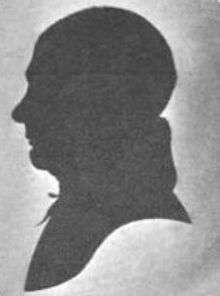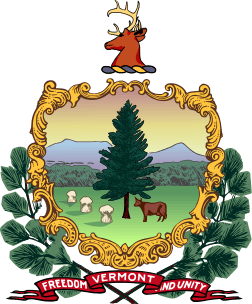Israel Smith
Israel Smith (April 4, 1759 – December 2, 1810) was an American lawyer and politician. He held a wide variety of positions in the state of Vermont, including as a member of the United States House of Representatives, a member of the United States Senate and Governor of Vermont.
Israel Smith | |
|---|---|
 Silhouette of Israel Smith (only known likeness) | |
| 4th Governor of Vermont | |
| In office October 9, 1807 – October 14, 1808 | |
| Lieutenant | Paul Brigham |
| Preceded by | Isaac Tichenor |
| Succeeded by | Isaac Tichenor |
| United States senator from Vermont | |
| In office March 4, 1803 – October 1, 1807 | |
| Preceded by | Nathaniel Chipman |
| Succeeded by | Jonathan Robinson |
| Member of the U.S. House of Representatives from Vermont's 1st district | |
| In office October 17, 1791 – March 3, 1797 | |
| Preceded by | District created |
| Succeeded by | Matthew Lyon |
| In office March 4, 1801 – March 3, 1803 | |
| Preceded by | Matthew Lyon |
| Succeeded by | Gideon Olin |
| Personal details | |
| Born | April 4, 1759 Suffield, Colony of Connecticut, British America |
| Died | December 2, 1810 (aged 51) Rutland, Vermont, U.S. |
| Political party | Democratic-Republican |
| Profession | lawyer / politician |
Early life
Smith was born in Suffield in the Colony of Connecticut, where he spent his childhood. He studied at Yale University and graduated in 1781.[1] He studied law with his brother Noah Smith, and was admitted to the bar. He began his law practice in Rupert, Vermont.
He married Abiah Douglass (1767-1836), and they had two children, William (1785-1822) and Horace (1787-1790). After Israel Smith's death Abiah married Colonel William C. Harrington, who became an attorney in Burlington, Vermont.
Career
Smith began his political career in 1785 when he served as a member of the Vermont House of Representatives. He served in the Vermont House again from 1788 to 1791. During this period, he was active in solving Vermont's boundary disputes with other states and served as a delegate to the Vermont Constitutional Convention, at which Vermont ratified the American Constitution. By 1790 Smith had moved to Rutland, Vermont.
When Vermont became a state in 1791, Smith ran for Vermont's seat in the United States House of Representatives. In a bitterly fought election between Smith, Matthew Lyon and Isaac Tichenor, Smith received second place, 35% of the vote in the first round, but won the runoff against Lyon. Smith represented Vermont's 1st District in the U.S. House from 1791 to 1797.[2] In 1792 and 1794, Lyon unsuccessfully ran against Smith, but in 1796 Smith was defeated by Lyon. By this time, Smith had become a member of the Democratic-Republican Party.[3]
In 1797, Smith again briefly served in the Vermont State House. He became Chief Justice of the Vermont Supreme Court in 1797,[4] but resigned the following year. In 1800, Smith was reelected to the United States House of Representatives, where he served until 1802.
In 1802, Smith was elected to the United States Senate from Vermont, and served in the Senate from 1803 to 1807. In 1807 he successfully ran against one of his old political rivals, Isaac Tichenor, for governor. Tichenor had served as governor for a decade. Smith resigned from the Senate and served as Governor of Vermont from 1807 to 1808, when he was defeated for reelection by Tichenor.[5] Smith served as Vermont's fourth Governor.
Death and legacy
After leaving the governorship, Smith moved back to Rutland, Vermont, where he retired from politics. He became ill and died in Rutland. He is interred at West Street Cemetery in Rutland.[1] His home in Rutland has been preserved.[6]
References
- "SMITH, Israel, (1759 - 1810)". Biographical Directory of the United States Congress. Retrieved October 22, 2012.
- "Sen. Israel Smith". govtrack.us. Retrieved October 22, 2012.
- "Governor of Vermont". NNDB. Retrieved October 22, 2012.
- "Vermont Justices of the Supreme Court" (PDF). Vermont State Archives and Records Administration. Archived from the original (PDF) on April 15, 2012. Retrieved October 22, 2012.
- "Vermont Governor Israel Smith". National Governors Association. Retrieved October 22, 2012.
- "Israel Smith". Rutland Historical Society. Retrieved October 22, 2012.
External links
- United States Congress. "Israel Smith (id: S000557)". Biographical Directory of the United States Congress.
- National Governors Association
- Israel Smith at Find a Grave
- govtrack.us
- A Guide to the Papers of Vermont's Governors
- Rutland Historical Society
- Vermont: The Official State Website
| Party political offices | ||
|---|---|---|
| Preceded by Moses Robinson |
Democratic-Republican nominee for Governor of Vermont 1799, 1800, 1801, 1802 |
Succeeded by Jonathan Robinson |
| Preceded by Jonathan Robinson |
Democratic-Republican nominee for Governor of Vermont 1806, 1807, 1808 |
Succeeded by Jonas Galusha |
| U.S. House of Representatives | ||
| Preceded by District created |
Member of the U.S. House of Representatives from Vermont's 1st congressional district 1791-1797 |
Succeeded by Matthew Lyon |
| Preceded by Matthew Lyon |
Member of the U.S. House of Representatives from Vermont's 1st congressional district 1801-1803 |
Succeeded by Gideon Olin |
| U.S. Senate | ||
| Preceded by Nathaniel Chipman |
U.S. senator (Class 1) from Vermont 1803–1807 Served alongside: Stephen R. Bradley |
Succeeded by Jonathan Robinson |
| Political offices | ||
| Preceded by Isaac Tichenor |
Governor of Vermont 1807–1808 |
Succeeded by Isaac Tichenor |

